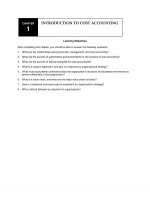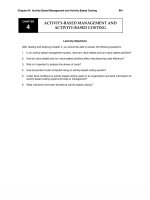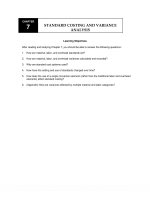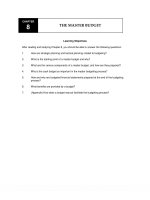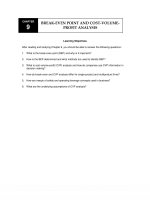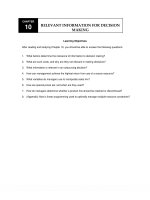Solution manual management advisory services by agamata chapter 14
Bạn đang xem bản rút gọn của tài liệu. Xem và tải ngay bản đầy đủ của tài liệu tại đây (159.71 KB, 21 trang )
This Accounting Materials are brought to you by www.everything.freelahat.com
CHAPTER 14
CAPITAL BUDGETING
[Problem 1]
Purchase price
Trade-in allowance
Saving from repairs
Additional tax on savings (P25,000 x 40%)
Net cost of investment for decision analysis
P140,000
( 7,000)
( 25,000)
10,000
P118,000
[Problem 2]
Purchase price
P4,800,000
Freight and installation
45,000
Trade-in allowance
( 200,000)
Salvage value of other assets
12,000
Tax savings – other assets
(
8,000)
Savings from repairs
( 400,000)
Add’l tax on savings from repairs (P400,000 x 40%) 160,000
Additional working capital
350,000
Net cost of investment for decision analysis
P4,759,000
[Problem 3]
Purchase price
Freight charge
Installation costs
Special attachment
Add’l working capital
Proceeds from sale of old assets
Tax savings (P38,000 x 25%)
Savings from repairs
P900,000
25,000
22,000
55,000
110,000
( 22,000)
( 9,500)
( 120,000)
Add’l tax on savings from repairs (P120,000 x 25%)
30,000
Net cost of investment for decision analysis
P990,500
[Problem 4]
Furnishing and equipment
Rental deposits
Accounts receivable (P9M x 1/3 x 2/3)
Inventory
Cash
Net cost of investment for decision analysis
P 500,000
200,000
2,000 000
400,000
120,000
P5,020,000
This Accounting Materials are brought to you by www.everything.freelahat.com
[Problem 5]
1. Sales
Materials
Labor
Factory overhead
Selling and administrative expenses
Depreciation expense (P1,200,000 5 yrs)
Income before income tax
Tax (30%)
Net income
Add back: Depreciation expense
2. Annual net cash flows
P6,000,000
( 800,000)
( 1,200,000)
( 540,000)
( 700,000)
( 240,000)
2,520,000
( 756,000)
1,764,000
240,000
P2,004,000
[Problem 6]
1.
Weighted Average Cost of Capital (WACOC) = ?
Sources of
capital
Market values
Individual Cost of
Capital
Capital Mix
WACOC
Fraction
Mortgage bonds
(P300,000 x 105%) = P315,000
(10% x 55%) = 5.5%
Preferred equity
(2000 sh x P96)
= 192,000
(P12 / P96) = 12.5
192 / 1.007
2.38%
Common equity
(50,000 sh x P10) = 500,000
P1.50 / P10 = 15.0
500 / 1.007
7.45%
Total
315 / 1.007
P1,007,000
11.55%
Preferred dividends = 12% x P100 = P12 / sh
Earnings per share = P75,000 / 50,000 sh = P1.50
2.
Proposed
Investment
A
B
C
ROI
7%
10%
14%
WACOC
11.55%
11.55%
11.55%
1.72%
Advise
Reject
Reject
Accept
Investments are to be accepted if the WACOC is higher than the ROI.
This Accounting Materials are brought to you by www.everything.freelahat.com
[Problem 7]
1.
New WACOC = ?
Cost of
Sources of
Money
Long-term
debt
Preferred
equity
Common
equity
Package 1
Capital
6%
Amount
Amount
3%
P 2,000 000
3,000,000 1.65%
14%
Total
7,000,000 4.90%
P20,000,000
2.
WACOC
P10,000,000
11%
Package 2
9.55%
Package 3
WACOC
11,000 000
7,000,
000
P20,000,000
Amount
WACOC
0.60% P 6,000,000
1.80%
6.05%
5,000,000
2.75%
4.90%
9,000,000
11.55% P20,000,000
6.30%
10.85%
Package 1 gives the invest WACOC at 9.55%.
[Problem 8]
Before Bonds Retirement
Amount
Bonds
Preferred
equity
Common
equity
WACOC
WACOC
P 5,000,000 (8% x 60% x 5/10) = 2.4%
1,000,000 (9% x 1/10)
4,000,000 (12.5% x 4/10)
Lease
Totals
After Bonds Retirement
Amount
P10,000,000
P4,000,000 (8% x 60% x 4/10) = 1.92%
1,0
= 0.9%
00,000 (9% x 1/10)
= 0.90%
4,0
= 5%
00,000 (12.5% x 4/10)
= 5.0%
1,
000,000
10% x 60% x 1/10) = 0.60%
P
8.30% 10,000,000
8.42%
[Problem 9]
a.
WACOC = ?
Funds
Mortgage bonds
Common stock
Ret earnings
Total
Amount
P20,000,000
25,000,000
55,000,000
P100,000,000
Individual Cost of
Capital
WACOC
[(6.5% x 50%) / 95%] 3.42%
0.684%
[(P4 x 105%) /P94 + 5%] 9.47 2.3675%
9.47 5.2085%
8.26%
b. The weighted average cost of capital is used as a benchmark in
evaluating the acceptability or rejection of proposed investment because
it measures the point of expected return where the minimum required
return of each class of investor is met by reason of cross-subsidizing
from one class of security to another.
[Problem 10]
This Accounting Materials are brought to you by www.everything.freelahat.com
a. WACOC under each alternative
Debt
Equity
WACOC
b.
Alternative A
(9% x 50% x 2/6) = 1.5%
{[(P1/P20) + 7%] x 4/6} = 8.0%
9.5%
Alternative B
(12% x 50% x 4/6)
= 4.0%
{[(P0.90/P20) + 12%] x 2/6} =
5.5%
9.5%
In alternative B, the amount of debt increases thereby increasing the
debt equity ratio signalling the firm is highly leveraged and more risky for
investment. This tends to increase the nominal rate of the bonds.
c. Yes; it is logical for stockholders to expect a higher dividend growth rate
under alternative B to compensate the higher rate implied by an increase
in the debt exposure of the firm and to validate the theory that the more
debt is used in the financing portfolio, the higher the profitability rate of
the firm, thereby, the higher the growth rate.
[Problem 11]
1.
Marginal Cost of Capital for each fund
2.
WACOC = ?
Capital
Mix
[b]
Sources
Rate
WACOC
Mortgage bonds
15.00%
1.26%
Debentures
25.00%
2.175%
Preferred stock
10.00%
1.36%
Common stock
16.67%
2.11%
(P1.80 / P67.50 + 10%)=12.67%
Retained earnings
33.33%
4.22%
= 12.67%
100.00%
11.125%
3. Maximum point of expansion for retained earnings:
Net income (P4.50 x 15 million shares)
P67,500,000
Common dividends (P67,000,000 x 40%
or P1.80 x 15 million)
( 27,000,000)
Preferred stock dividends
( 6,750,000)
Retained earnings available for expansion P33,750,000
Common equity = 50% of total capitalization
Maximum point of expansion before common stock
shares are issued = P33,750,000 / 50% = P67.5M
[a]
Individual COC
(14% x60%)
= 8.4%
(145% x 60%)
= 8.7%
(P13.50/ P99.25) = 13.60%
This Accounting Materials are brought to you by www.everything.freelahat.com
4.
The WACOC varies among firms in the industry even if the basic
business risk is similar for all firms in the industry. This is true because
each firm selects the degree of financial leverage it desires. This
financial leverage affects the capital mix structure of a firm that affects
the determination of the weighted average cost of capital.
[Problem 12]
1.
WACOC before and after bond retirement:
[1] Before Bond Retirement
Capital
Amount
[2] After Bond retirement
WACOC
Amount
Lease
WACOC
P1,000,000
(10% x 60% x 1/10) = 0.6%
8% Debentures
9% Preferred
stock
P5,000,000
8% x 60% x 5/10) = 2.4%
4,000,000
(8% 60% x 4/10) = 1.92%
1,000,000
(9% x 1/10) = 0.9%
1,000,000
{same} 0.9%
Common stock
Retained
earnings
2,000,000
(13% x 2/10) = 2.6%
2,000,000
{same} 2.6%
2,000,000
(13% x 2/10) = 2.4%
2,000,000
{same} 2.4%
8.30% P10,000,000
8.42%
P10,000,000
2.
The component costs and the weighting used to calculate the WACOC
in a-1 is different in a-2 because P1 M of debentures are replaced by
lease which is more expensive (from 8% to 10% nominal rate). This
brings up the WACOC to 8.42%.
3. Market values should be used in calculating the WACOC because COC
calculation is used to estimate the current marginal cost of capital for the
company. The use of market values
a.
recognizes the current investor attitudes regarding the
company’s risk position and will reflect current rates for capital.
b. recognizes better the capital proportions the company must consider
in the capital sources decision; and
c. ignores the influence of past values which are not relevant to future
decision.
[Problem 13]
1. The board member’s agreement is incorrect because the facts seem to
indicate that Kia Corporation’s capitalization is not in optimum mix (i.e.,
equilibrium). The issuance of new debt will increase the financial
leverage of the firm, increases the risk, increases the note’s nominal rate,
and decreases the earnings multiple. While the marginal cost of capital
is a combination of explicit interest cost on the notes and the additional
cost of earnings that must occur to compensate the common
This Accounting Materials are brought to you by www.everything.freelahat.com
stockholders for the decline in the earnings multiple. The 14% return in
this project should be compared with the new weighted average cost of
capital if the issuance of note is undertaken.
2. New level of annual earnings of the earnings multiple declines to 9 =?
1.
Present market price per share = 10(P2.70) = P27.00
Required EPS (new) = P27/9 = P3.00
Required earnings before tax
(P3.00 x 10,000,000 shares / 50%)
P 60,000,000
Interest expense
[(P10 M x 8%) + (P50M x 10%)]
5,800,000
Required earnings before interest and taxes
65,800,000
Less: Old earnings before interest and taxes
{[(P2.70 x 10,000,000 shares) / 50%] + P800,000} 54,800,000
Additional earnings before interest and taxes
P 11,000,000
Additional informational analysis:
If the earnings multiple declines to 9, the additional earnings
provided by the new assets to maintain the same market price
per share of P27 shall be:
X = additional earnings
(new P/E) (new EPS) = P27
9 ( P2.70 + X) = P27
2.70 + X = P3
X = P0.30
[Problem14]
1. Breaks = ?
Breaks or increases in weighted marginal cost of capital will recur as
follows:
For Debt = Debt / Debt Ratio
= P100,000 / 40% = P250,000
For Equity = Equity / Equity Ratio = P150,000 / 60% = P350,000
2. WACOC = ?
a.
Before the break (P1 – P250,000 amount of financing)
i.
Debt = 7% x 40% = 3.2%
ii.
Equity = 18% x 60% = 10.8%
iii.
WACOC
14.0%
b.
After the break (P250,001 – above amount of financing)
Debt = 10% x 40% = 4.0%
Equity = 22% x 60% = 13.2%
WACOC
17.2%
This Accounting Materials are brought to you by www.everything.freelahat.com
3. Graph of marginal cost of capital (MCC) schedule and investment
opportunities schedule (IOC):
26
24
IRR (
)
22
A
MCC (------)
20
18
B
MCC
16
14
12
C
10
8
6
4
2
0
100
200 225 300
400 450 500 (new financing,
thousands of
pesos)
4. Projects are to be accepted as long as the IRR is greater than the MCC.
Projects A and B are acceptable; based on the following:
Project
A
B
C
IRR
19%
15%
12%
MCC
14%
14%
17.20%
Advise
Accept
Accept
Reject
[Problem15]
1. EPS and market price per share = ?
a. Raise P100,000 by issuing 10-year, 12% bonds
Case 1
Sales
P 400,000
- Costs and operating expenses (90%)
360,000
EBIT
40,000
-Interest charges
[P2,000 + (12% x P100,000)]
14,000
IBIT
26,000
- Tax (50%)
13,000
Net Income
P 13,000
P1.30
Earnings per share
Case 2
P 600,000
540,000
60,000
Case 3
P 800,000
720,000
80,000
14,000
46,000
23,000
P 23,000
P2.30
14,000
66,000
33,000
P 33,000
P3.30
This Accounting Materials are brought to you by www.everything.freelahat.com
(NI / 10,000 shares)
Price / earnings rates
Market price per share
EPS (old)
= P36 / 12
=
No. of shares = P30,000 / P3 =
b.
10x
P13
10x
P23
10x
P33
Case 1
P 400,000
360,000
40,000
2,000
38,000
19,000
P 19,000
Case 2
P 600,000
540,000
60,000
2,000
58,000
29,000
P 29,000
Case 3
P 800,000
720,000
80,000
2,000
78,000
39,000
P 39,000
P1.46
12x
P17.52
P2.23
12x
P26.76
P3.00
12x
P36
13,000
13,000
13,000
3
10,000 sh
Raise P100,000 by issuing new column stock
Sales
- Costs and D Exp (90%)
EBIT
-Interest expense
IBIT
- Tax (50%)
Net Income
Earnings per share
(NI / 13,000Shares)
Price / earnings rates
Market price per share
No. of shares
(P100,000 / P33.33 + 10,000)
2.
Recommended proposal = ?
The recommendation shall be based on the following criteria:
Brief desorption of
the criteria
The proposal chosen
Wealth Maximization
Wealth maximization is
primordial
among
shareholders in as much
as this is the end
objective of business.
This wealth maximization
principle is represented
by the market price per
share.
The total sales of the
firm should be higher
than P600,000, since its
sales last year was
already at P600,000. At
this level and more, the
Profit Maximization
Profit maximization
is a short-run strategy
to satisfy the interest
of shareholders. This
profit
maximization
strategy
is
.best
represented by the
earnings per share.
This Accounting Materials are brought to you by www.everything.freelahat.com
market price per share is
higher by issuing a new
share of stock. Wealth
maximization
is
a
strategic
reason
of
managing a business,
hence,
at
guides
organization in its longterm decisions, such as
financing decision.
3.
No, the financing package chosen would be the same. The
higher the level of sales in excess of P600,000, the more
favorable it is on the part of the business!
4.
The investment banker would rationalize that issuance of more
debt securities would mean a greater variability in earnings and
higher risk of bankruptcy created by the fixed commitment to pay
debt interest and principal. This would bring restrain by
diminishing the earnings multiple to compensate the increased
risk in leverage.
[Problem 16]
1.
Sales
P600,000
Out-of-pocket costs
( 450,000)
Depreciation expense (P500,000/5)
( 100,000)
IBIT
50,000
Tax (40%)
( 20,000)
Net income
30,000
Depreciation expense
100,000
Annual cash inflows
P130,000
Payback period
= P500,000 / P130,000
=
3.85 yrs
2.
3.
4.
25.97%
6%
12%
Payback reciprocal
ARR (original)
ARR (average)
= 1 / 3.85
= P30,000/P500,000
= [P30,000 / (P500,000/2)[
[Problem 17]
Year
Annual
Cash
Income,
Net of Tax
Cash to
Date
Payback
Period
=
=
=
This Accounting Materials are brought to you by www.everything.freelahat.com
1
2
3
4
P 70,000
90,000
85,000
160,000
Total
P 70,000
160,000
245,000
400,000
1
1
1
0.97
3.97
(155,000/160,000)
yrs.
[Problem 18]
Net Cash Cash to
Inflows
Date
P300,000 P300,000
400,000
700,000
200,000
900,000
150,000 1,000,000
Year
1
2
3
4
Salvage
Total
Value
Cash
P200,000 P500,000
100,00
800,000
50,000
950,000
20,000 1,000,000
Total
Payback
Period
1
1
1
0.53
3.53
[Problem 19]
1.
Cash flows before tax
Depreciation expense (P1,000,000/ 10)
IBIT
Tax (40%)
Net income
2.
ARR (original) = P60,000 / P1 million
=
ARR (average) = [P60,000 / (P1 million/2)] =
(100,000 - 20,000
150,000
yrs.
P200,000
( 100,000)
100,000
( 40,000)
P 60,000
6%
12%
[Problem 20]
1.
Sales
P4,000,000
Out-of-pocket costs
( 3,100,000)
Depreciation expense [(P2M x 80%)/5]
( 320,000)
IBIT
580,000
Tax (40%)
( 232,000)
Net income
348,000
Add: Depreciation expense
320,000
Annual net cash inflows
P 668,000
Payback period = P 2 million / P668,000
=
2.99 yrs.
2.
Payback reciprocal = 1 / 2.99
=
33.44%
3.
Payback bailout period = [(P4 4M x 80%) / P668,000] = 4.79 yrs.
4.
ARR (original) = P348,000 / P4 M
= 8.7%
5.
ARR (average) = [(P348,000 / (P4 M + P800,000) / 2] = 14.5%
This Accounting Materials are brought to you by www.everything.freelahat.com
[Problem 21]
1.
Cash flows before tax
- Tax [(P15,000 – P5,000) 40%]
Cash flows after tax
Payback period (P40,000 / P11,000)
2.
P15,000
4,000
P11,000
3.64 yrs.
Cash flows after tax
P11,000
Less: Depreciation expense
5,000
Net income
P 6,000
ARR (original) = P6,000 / P40,000 = 15%
[Problem 22]
1.
PVCI:
Annual cash inflows (P300,000 x 3.127) P938,100
Salvage value (P20,000 x 0.437)
8,740 P946,840
Less: COI
800,000
Net present value
P146,840
2.
Profitability index = P946,840 / P800,000 = 1.184
3.
NPV index = P146,840 / P800,000
= 0.184
[Problem 23]
1.
Year
1
2
3
4
5
SV
2.
3.
Annual
Cash
PVF at
12%
PVCI
Inflows
P350,000
0.893
P312,550
250,000
0.797
199,250
150,000
0.712
106,800
100,000
0.636
63,600
50,000
0.567
28,350
30,000
0.567
17,010
Total
727,560
Less: Cost of investment 600,000
Net present value
P 127,560
Profitability index = (P727,560/P600,000) = 1.21
NPV index
= P127,560 / P600,000 = 0.21
[Problem 24]
This Accounting Materials are brought to you by www.everything.freelahat.com
PVF at
Year
14%
Proj. 1
Proj. 2
Proj. 3
1
0.877
P2,104,800 P4,823,500 P175,400
2
0.769
1,691,800
1,999,400
461,400
3
0.675
1,215,000
472,500
675,000
4
0.592
651,200
118,400
473,600
SV
0.592
118,400
118,400
47,360
Total PVCI
P5,781,200 P7,532,200 P1,832,760
COI
P5,000,000 P8,000,000 P1,400,000
Profitability index
1.16
0.94
1.31
The company should make investments on the following projects:
Rank 1
Proj. 3
P 1,400,000
Rank 2
Proj. 1
5,000,000
Total investment
P 6,400,000
[Problem25]
1.
Annual cash inflows:
(P500,000 x 3.889)
(P400,000 x 3.889)
Salvage value
(P100,000 x 0.456)
Recovery of working capital
(P200,000 x 0.456)
(P1,400,000 x 0.456)
Total PV of cash inflows
Less: COI
(P1,400,000 + P200,000)
(P200,000 + P1,400,000)
Net present value
2.
3.
Profitability index (PVCI / COI)
Produce
Wooden
Toy
Distribute
an Imported
Product
P 1,944,500
P
1,555,600
45,600
91,200
638,400
2,194,000
2,081,300
1,600,000
P
481,300
1.30
P
1,600,000
594,000
1.37
The net advantage of investing in distributing an imported product is
P112,700 (i.e., P534,000 – P481,300).
This Accounting Materials are brought to you by www.everything.freelahat.com
{Problem 26]
Year
1
2
3
4
Project X
Project Y
Cash to
Cash to
PVFC 14%
PVCI
PVCI
Date
Date
0.887 P 1,754,000 P 1,754,000 P 3,069,500 P 3,069,500
0.769
1,538,000 3,292,000
1,922,500
4,992,000
0.675
1,350,000 4,642,000
1,012,500
5,000,000
0.592
1,184,000 5,000,000
Payback period – Proj X
Payback period – Proj Y
[3 yrs. + (P358,000/P1,184,000)] 3.30 yrs.
[2 yrs. + (P8,000/P1,012,500)]
2.01 yrs.
[Problem 27]
a.
PVF Annuity =
b.
P520,000
=
2.6
P200,000
Using Table 2 (PVFA Table), the IRR is computed as follows:
18%
2.690
?
2.600
0.090
2%
0.102
0.012
20%
IRR
=
18%
[Problem 28]
a.
PVF Annuity =
2.588
+
0.090
x 2%
0.102
P800,000
P234,000 *
= 19.75%
= 3.419
* (P234,000 = [(Total cash inflows + SV) 5]
b.
Using Table 2, the PVF of 3.419 is between 14% and 16%
b.1.
Using 16% and 18% discount rates we have:
PVCI @ 16%
Year
1
2
3
4
5
Cash Inflows
P
350,000
300,000
250,000
150,000
80,000
PVF
0.862 P
0.743
0.641
0.552
0.476
Amount
301,700
222,900
160,250
82,800
38,080
PVCI @ 18%
PVF
0.847 P
0.718
0.609
0.516
0.437
Amount
296,450
215,400
152,250
77,400
34,960
This Accounting Materials are brought to you by www.everything.freelahat.com
SV
Totals
b.2.
40,000
0.476
19,040
824,770
P
0.437
P
17,480
793,940
Since the cost of investment of P800,000 is found the present
value of cash inflows (PVCI) of 16% and 18%, then by
interpolation, the IRR, could be determined as:
Discount
rate
16%
PVCI
P824,770
?
800,000
24,770
2%
30,830
6,060
18%
IRR
=
16%
793,940
+
24,770
x 2%
30,830
= 17.61%
[Problem 29]
1.
PV of cash dividends (1,400 shares x P20 x 3.791)
PV of stock sales (P200,000 x 0.621)
PV of the shares of stock
Less: Cost of the share of stock
Net present value
2
P106,148
124,200
230,348
203,000
P 27,348
a)
P203,00
P230,000
= 0
= 2.988
{[(1,400 x P20) x 5 + P200,000] + 5}
P68,000
Using Table 2 (PVFA Table), we have:
PV
Annuity
b)
=
20%
2.991
0.006
2%
2.985
?
22%
IRR
[Problem 30]
=
20%
0.127
0.121
2.864
+
0.006
0.127
x 2%
= 20.09%
This Accounting Materials are brought to you by www.everything.freelahat.com
Background analysis:
Cash savings before depreciation (P138,600 - P91,300) P47,300
Less: Depreciation expense
20,000
Income before income tax
27,300
Less: Tax (40%)
10,920
Net Income
16,380
Add: Depreciation expense
20,000
Annual Cash Inflows
P36,380
1. Payback period
= P160,000/P36380
= 4.40 yrs.
2. Payback reciprocal = 1/.P4.40
= 22.73%
3. ARR (original)
= P16,380/P160,000
= 10.24%
ARR (average)
= P16,380/(P160,000/2)
= 20.48%
4. PVCI (P36,380 x 5.747)
P209,076
Less: Cost of Investment
160,000
Net Present Value
P 49,076
5. Profitability index = P209,076/P160,000
= 1.31
6. NPV index
= P49,076/P160,000
= 0.31
7. a. PVF annuity = P160,000/P36,380
= 4.398
b. Using Table 2, we have:
14%
4.639
?
4.398
0.241
2%
0.295
0.054
16%
IRR
=
14%
4.344
+
0.241
0.295
x 2%
= 15.63%
[Problem 31]
Depreciation
Expense
Year
1
2
3
4
SY
P3.2M
2.4M
1.6M
0.8M
Tax Effect
PV of Tax
PVF
at
SL
8% Savings
P(444,480
P2.0M P1.2M P(480,000) 0.926
)
2.0M 0.4M (160,000) 0.857 (137,120)
2.0M (0.4M) 160,000 0.794 127,040
2.0M (1.2M) 480,000 0.735 352,800
This Accounting Materials are brought to you by www.everything.freelahat.com
Total
P101,760
[Problem 32]
Cash
Net Cash
Flows
Straight Line
Method
(P2,400,000 P1,430,000)
Sum-of-theyears-digit
method
1.a.
b.
Inflows
Before
Dep.
Tax
Expense
IBIT
Tax (30%)
Net
Dep.
After
Income
Expense
Tax
P970,000
P360,000
P610,000
P183,000 P427,000 P360,000
Year 1
P970,000
640,000
330,000
99,000
231,000
640,000
871,000
Year 2
P970,000
560,000
410,000
123,000
287,000
560,000
847,000
Year 3
P970,000
480,000
490,000
147,000
343,000
480,000
823,000
Year 4
P970,000
400,000
570,000
171,000
399,000
400,000
799,000
Year 5
P970,000
320,000
650,000
195,000
455,000
320,000
775,000
Year 6
P970,000
240,000
730,000
219,000
511,000
240,000
751,000
Year 7
P970,000
160,000
810,000
243,000
567,000
160,000
727,000
Year 8
P970,000
80,000
890,000
267,000
623,000
80,000
703,000
Annual cash inflows after tax:
Alternately, cash inflows after tax may be computed by deducting the
corresponding income tax from the cash flows before tax. The tax
expense equals cash flows before tax less depreciation expense.
Net present values, straight-line method and SYD method
PVCI:
Regular(P787,000 x 5.747)
Y1 (P871,000 x 0.926)
Y2 (P847,000 x 0.857)
Y3 (P823,000 X 0.794)
Y4 (P799,000 X 0.735)
Y5 (P775,000 X 0.681)
Y6 (P751,000 X 0.630)
Y7 (P727,000 X 0.583)
Y8 (P703,000 X 0.540)
SV (P120,000 X 0.540)
Straight-line
P4,523,889
64,800
SYD
P806,546
725,879
653,462
587,265
527,775
473,130
423,841
379,620
64,800
P787,000
This Accounting Materials are brought to you by www.everything.freelahat.com
Recovery of working capital
(P400,000 x 0.540)
Cost of investment(P3M +
P400,000)
Net present value
216,000
(3,40
0,000)
P1,403.689
Advantage of the SYD method
2.
216,000
(3,400,000)
P1,458,328
P
54,639
The tax benefit using SYD method instead of the straight-line method
is P54,639 (i.e., P1,458,328 - P1,403,689).
[Problem 33]
1.
Purchase price
PV of lease payments (P30,000 x 5.650)
PV of salvage value (P200,000 x 0.322/64,400)
PV of tax savings on depreciation expense
(P200,00 x 35% x 5.650)
PV of tax savings on lease payments
(P300,000 x 35% x 4.65)
PV of relevant costs
2.
Buy
P2,200,000
(
64,400)
(
395,500)
P1,740,100
Net Advantage of leasing
PV of annual savings (P638,350/5.65)
Lease
P1,695,000
( 64,400)
( 93,250)
P1,101,750
P638,350
P112,982
[Problem 34]
1.
Payback period = P35,000/P10,000 = 3.5 yrs.
2.
PVCI (P10,000 x 3.785)
Less: Cost of investment
Net present value
3.
Amount of investment
six years ago
P37,850
35,000
P 2,850
=
=
=
P35,000
Future Value Factor @ 15%, n = 6
P35,000
2.313
P15.132
[Problem 35]
1.
PV of cash dividends (20,000 shares x P4 x 3.605) P288,400
PV of stock sales (P500,000 x 115% x 0.567)
326,025
PV of shares of stock
614,425
This Accounting Materials are brought to you by www.everything.freelahat.com
2.
Less: cost of investment
Net present value – common stock
500,000
P114,425
PV of interest receipts (P500,000 x 14% x 3.605)
PV of bond redemption (P500,000 x 150% x 0.567)
PV of bonds
Less: Cost of investment
Net present value – bonds
P252,350
425,250
677,600
500,000
P177,600
3. The investment in bonds is more advantageous by P63,175 (i.e.,
P177,600 – P114,425) than the investment in stock.
[Problem 36]
1.
Cost of investment
Less: Present values of inflows:
Y1 (P120,000 x 0.893)
Y2 (P240,000 x 0.797)
Y3 (P360,000 x 0.712)
Present value of year 4 inflows
PVFC 12%, year 4
Cash inflows, year 4
P681,960
(107,160)
(191,280)
(256,320)
127,200
0.636
P200,000
2.
PV of savings (P700,000 x 5.197)
Less: Cost of investment
Net present value of intangible benefits
3.
PVF Annuity = P1,027,750 = 4.11*
P250,000
P3,637,900
3,000,000
P 637,900
*Using table 2, 4.11 at 12% = 6 yrs.
[Problem 37]
1.
.
Savings from labor and materials
Increase in maintenance
(P6,000 x 12)
Annual cash savings
2.
PVCI
Regular cash (P784,000 x 3.433)
Salvage value (P180,000 x 0.579)
Y1 - Y3
P 820,000
Y4 - Y5
P 820,000
(72,000)
P 784,000
(72,000)
P 784,000
P2,567,884
93,420
P2,661,304
This Accounting Materials are brought to you by www.everything.freelahat.com
Less: Cost of investment (P2,700,000 – P70,000)
Net present value
P
2,630,000
(31,304)
3.
Annual cash savings
Depreciation expense
P
Y1 - Y3
748,000
Y4 - Y5
P 748,000
(504,000
)
P2,700,000 - P180,000
5 yrs.
[P504,000 + (P150,000/2)]
Income before income tax
Less: Tax (40%)
Net income
Add: Depreciation expense
Annual cash inflows
P
244,000
97,600
146,400
504,000
650,400
(579,000
)
169,000
67,600
101,400
579,000
P 680,400
PVCI
Y1 – Y3 (P650,400 x 2.322)
P1,510,229
Y4 (P680,400 x 0.592)
402,797
Y5 (P680,400 x 0.519)
353,128
Salvage value – new (P150,000 x 0.519)
77,850
Less: Cost of investment (P2,700,000 – P70,000
Net present value
P2,344,004
2,630,000
P (285,996)
[Problem 38]
1.
Make
Buy
Relevant cost to buy / make
Year 1 (50,000 x P22 x 0.893)
982,300 P
1,294,850 (50,000 x P29 x 0.893)
Year 2 (50,000 x P22 x 0.797)
P
876,700
1,155,650 (50,000 x P29 x 0.797)
Year 3 (52,000 x P22 x 0.712)
814,528
1,032,400 (50,000 x P29 x 0.712)
Year 4 (55,000 x P22 x 0.636)
769,560
1,014,400 (55,000 x P29 x 0.636)
Year 5 (55,000 x P22 x 0.567)
686,070
904,365 (55,000 x P29 x 0.567)
Avoidable fixed overhead
(P45,000 x 3.605)
162,225
Salvage value - old asset
(1,500)
Salvage value - new (P12,000 x 0.567)
(6,804)
Tax savings on depreciation expense
This Accounting Materials are brought to you by www.everything.freelahat.com
Year 1 (P384,000 x 40% x 9.893)
(137,165)
Year 2 (P230,400 x 40% x 0.797)
(73,452)
Year 3 (P138,240 x 40% x 0.712)
(39,371)
Year 4 (P82,944 x 40% x 0.636)
(21,101)
Year 5 (P 124,416 x 40% x 0.567)
(28,218)
PV of relevant costs - 5 yrs.
P
3,883,772 P
Net advantage of making in 5 yrs.
P
1,517,913
2.
5,401,685
Some of the non-financial and qualitative factors to be considered
before deciding whether to make or buy a part are:
a. Availability of materials from supplier.
b. Stability of prices of material.
c. Quality of parts to be supplied.
d. Dependability of past supplier.
e. Impact of new technology.
[Problem 39]
1. Increase in direct materials [(P4.50 – P3.80) x 80,000]
Decrease in direct labor and variable
overhead (P1.60 x 80,000)
Net operating cash savings before tax
P (56,000)
128,000
P 72,000
Years
1
2
3
4
5
Cash savings before tax
P72,000
P72,000
P72,000
P72,000
P72,000
Less: Depreciation expense using SYD
800,000
640,000
480,000
320,000
160,000
Income before income tax
(728,000)
(568,000)
(408,000)
Less: Tax (40%)
(291,200)
(227,200)
(163,200)
Net income (loss)
(436,800)
(340,800)
(244,800)
Add: Depreciation expense
Annual cash inflows
2.
800,000
P363,200
640,000
P299,200
480,000
P235,200
(248,000)
(99,200)
(148,800)
320,000
P171,200
Regular operating cash inflows
(P363,200 + P299,200 + P235,200 + P171,200 + P107,200)
Salvage value (P100,000 x 60%)
Total cash inflows
Less: Cost of investment
Net cash inflows
P 1,176,000
60,000
1,236,000
2,500,000
P(1,264,000)
(88,000)
(35,200)
(52,800)
160,000
P107,200
This Accounting Materials are brought to you by www.everything.freelahat.com
Zero, there is no excess of after tax cash inflows over the cost of
initial investment because the total cash inflow is even lower than the
cost of investment.
